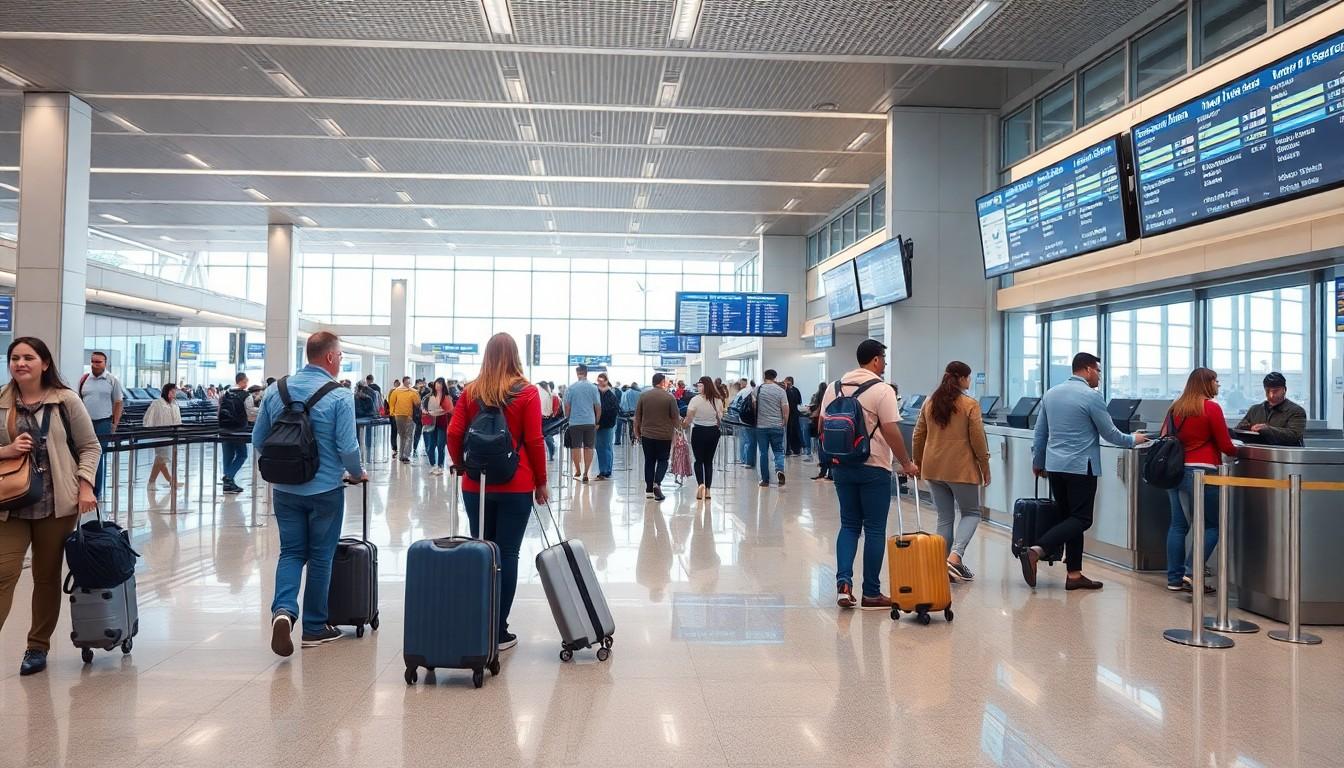Physical Address
304 North Cardinal St.
Dorchester Center, MA 02124

In a world where travel often feels like a game of Tetris, understanding transportation analytics can be the secret weapon for savvy travelers. Ever wondered why your flight was delayed or how to dodge traffic like a pro? With the right data, it’s possible to navigate the chaos and make travel smoother than a first-class upgrade.
Transportation analytics isn’t just for the techies; it’s for anyone who’s ever been stuck in an airport terminal or caught in a never-ending traffic jam. By harnessing the power of data, travelers can uncover insights that turn frustration into finesse. So buckle up as we dive into the world of travel transportation analytics and discover how it can transform the way people journey from point A to point B.
Travel transportation analytics involves the collection and analysis of data related to travel patterns, schedules, and behaviors. This field aids in improving traveler experiences by providing insights into various aspects of transportation. Understanding data helps in identifying peak travel times, optimizing routes, and predicting potential delays.
Data sources include GPS information, ticket sales, and traffic reports. These elements combine to create a clearer picture of travel dynamics. Travelers gain access to real-time information, enabling them to make informed decisions quickly. Tools for analyzing this data range from simple mobile applications to robust business intelligence software.
Consumers benefit from enhanced travel experiences through tailored recommendations and alerts. Insights derived from analytics can lead to more efficient itineraries, thus saving time and reducing frustration. Stakeholders in the travel industry, such as airlines and transportation services, also leverage analytics to streamline operations and boost customer satisfaction.
Applications of travel transportation analytics span various sectors. Airports use data to manage passenger flow effectively. Public transit authorities analyze ridership patterns to optimize schedules and improve service frequency. Ride-sharing companies utilize analytics to match drivers and passengers more efficiently.
Engaging with travel transportation analytics empowers travelers. Access to detailed information facilitates easier navigation through complex transportation systems. Enhanced awareness of travel data transforms how individuals approach their journeys, allowing them to avoid bottlenecks and discover alternate routes.
Travel analytics remains a key component in the evolution of the travel landscape. As technology advances, the integration of artificial intelligence and machine learning continues to refine data analysis. This evolution further enhances the potential benefits available to both travelers and service providers in an increasingly interconnected world.

Travel transportation analytics plays a crucial role in shaping efficient travel experiences. By leveraging data, it enhances understanding of travel dynamics, improving both efficiency and satisfaction.
Operational efficiency improves through the structured analysis of data. Airlines can manage resources effectively by identifying peak travel times and adjusting schedules accordingly. Transportation services benefit as well by optimizing routes based on real-time traffic patterns. Predictive analytics helps in forecasting demand, enabling better allocation of vehicles and staff. The integration of various data sources—such as GPS tracking and ticket sales—creates a streamlined flow of operations. Decision-makers can quickly react to unexpected events, reducing downtime and maximizing productivity.
Customer experience significantly improves due to travel transportation analytics. Tailored recommendations based on behavioral data help travelers make informed choices about routes and timing. Real-time alerts about delays or traffic conditions empower travelers to adjust plans proactively. Enhanced visibility into transit options leads to more seamless journeys. Stakeholders in the industry can identify customer pain points, allowing them to develop strategies to elevate service quality. All these factors contribute to a smoother, more enjoyable travel experience that meets the evolving needs of travelers.
Travel transportation analytics is vital for optimizing travel experiences. It encompasses various key components that collect, analyze, and interpret transportation data effectively.
Data collection methods play a crucial role in understanding travel dynamics. GPS data tracks vehicle movements and route efficiency. Ticket sales data provides insights into demand patterns across different times. Traffic reports offer real-time information about congestion, helping identify optimal travel times. Surveys and user feedback also contribute to a better understanding of traveler preferences and behavior. All these data sources together create a comprehensive overview of travel trends.
Analytical tools and techniques facilitate the interpretation of collected data. Statistical software analyzes large datasets to reveal patterns and trends. Machine learning algorithms predict potential travel disruptions by analyzing historical data. Data visualization tools present information in user-friendly graphics, making insights accessible. Simulation modeling helps stakeholders test various scenarios to optimize schedules and resources. These techniques empower travelers and industry professionals to make informed decisions based on actionable insights.
Travel transportation analytics faces significant challenges that impact its implementation and effectiveness. Addressing these challenges is critical to enhance traveler experiences.
Data privacy remains a primary issue in travel transportation analytics. Travelers express concern over how their personal data is collected and used by organizations. Regulations like the GDPR mandate strict compliance, forcing companies to ensure data protection and transparency. Without robust privacy measures, they risk losing consumer trust and facing legal repercussions. The challenge intensifies when balancing data utilization for analytics while respecting individual privacy rights. Organizations need to adopt clear policies and secure data practices to navigate this complex landscape.
Integrating analytics with existing systems presents a considerable hurdle. Various stakeholders, including airlines and public transit authorities, often rely on different technologies and platforms. Disparate systems can hinder the seamless sharing of data and analytics insights. Ensuring compatibility requires significant investment in both time and resources. Furthermore, standardizing data formats and processes is essential for effective communication between systems. Successful integration ultimately enhances operational efficiency and improves traveler experiences, but requires careful planning and execution.
Travel transportation analytics is evolving rapidly, with several trends shaping its future. Innovations in technology and data use will enhance travel experiences significantly.
AI and machine learning are becoming integral to travel transportation analytics. These technologies enable predictive analytics, allowing stakeholders to anticipate travel demand and optimize routes. With enhanced algorithms, airlines can reduce flight delays by adjusting schedules based on real-time data patterns. Additionally, machine learning helps personalize recommendations, enhancing customer satisfaction in ways that were previously unattainable. The implementation of AI tools facilitates efficient resource allocation, addressing traveler needs promptly. As a result, the adoption of these technologies significantly impacts operational efficiencies and traveler experiences.
Real-time data utilization is crucial for improving travel analytics. Immediate access to data enables stakeholders to respond quickly to changing conditions, such as traffic jams or flight delays. Applications that provide live updates help travelers adjust their plans on the fly, reducing frustration. Public transit authorities, for instance, use real-time data to enhance service reliability by dynamically adjusting schedules based on current demand. This approach not only maximizes efficiency but also elevates the overall travel experience. Utilizing real-time data fosters a more responsive travel environment, ensuring that travelers stay informed and empowered throughout their journeys.
Travel transportation analytics is transforming the way individuals approach their journeys. By leveraging data-driven insights travelers can navigate complexities and enhance their overall experience. The accessibility of these analytics empowers everyone to make informed decisions that streamline travel.
As technology continues to evolve the integration of AI and real-time data will further refine this field. Stakeholders will be better equipped to anticipate needs and optimize services. This not only benefits consumers but also enhances operational efficiency across the travel industry.
Ultimately the future of travel transportation analytics promises a more personalized and efficient travel experience. With ongoing advancements travelers can look forward to smoother journeys and greater satisfaction.